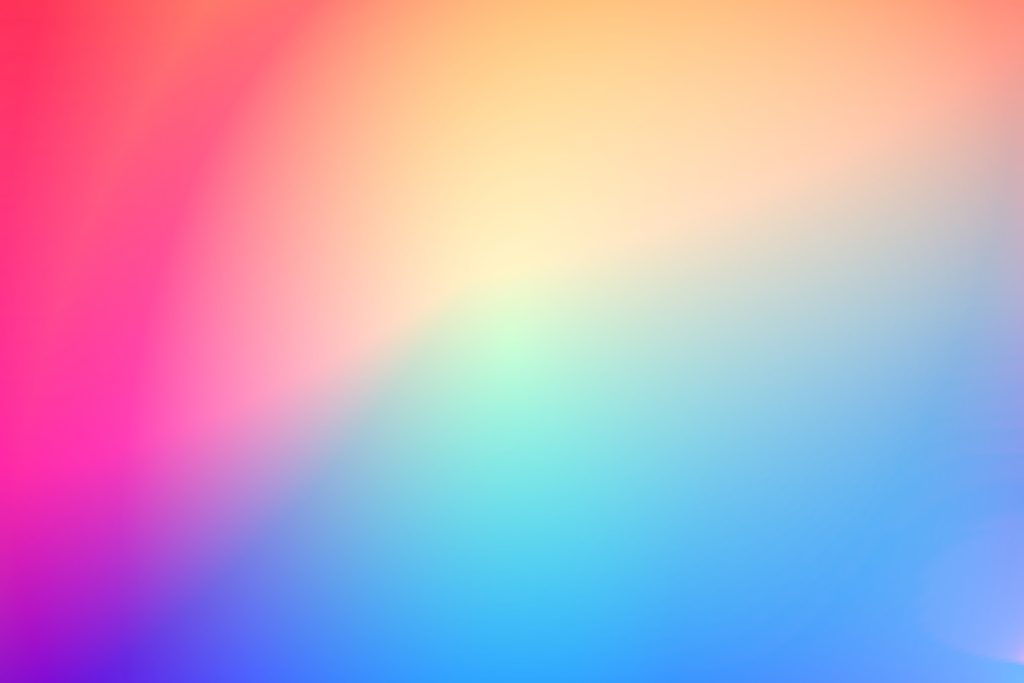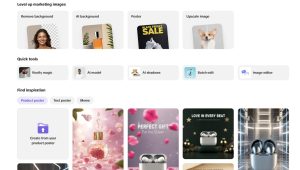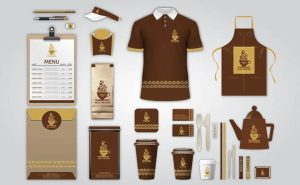Are you looking to create a visually appealing and impactful brand identity? One technique that has gained immense popularity is the use of gradients in logo design. Gradient color logo design is a powerful tool for adding depth and vibrancy to your brand.
A gradient logo is a type of logo that uses two or more colors to create a visually pleasing effect. Gradients, also called color ramps or color progressions, are colors that gradually fade, creating a smooth transition from one color to the next. Gradients come in three main varieties: linear, radial, and conic. Linear gradients are versatile and easily adapt to various shapes, giving your logo and brand a modern touch. Radial gradients, on the other hand, picture colors radiating outward from a central point, creating a circular pattern.
Gradient logos are a visually attractive way for brands in a variety of industries to make use of the modern, multicolored gradient logo trend. There’s no upper limit to the number of colors you can use in a gradient logo; as long as you have at least two, you can create an attractive gradient. So, if you’re looking to create a unique and eye-catching logo for your brand, incorporating gradients could be the way to go.
Understanding Gradient Colors
When it comes to designing a logo, one of the most important aspects to consider is the use of color. Using a gradient color scheme can add depth and style to your logo and make it more visually appealing. In this section, we will explore the concept of gradient colors and how they can be used in logo design.
A gradient is a gradual transition from one color to another. This transition can be linear, radial, or conic, depending on the effect you want to achieve. Gradients can be simple or colorful, and they can be used to create a 3D effect or add contrast to your design.
One of the benefits of using a gradient color scheme is that it allows you to use multiple colors in your logo without making it look cluttered or overwhelming. You can create a smooth transition from one color to another, or use a color ramp to create a more gradual blend of colors.
Linear gradients are the most common type of gradient used in logo design. They create a smooth transition from one color to another in a straight line. Radial gradients, on the other hand, create a circular blend of colors that radiate out from a central point. Conic gradients create a cone-shaped blend of colors, which can be used to create a more dynamic effect.
When using a gradient color scheme in your logo design, it’s important to consider the color combinations you use. You can use a blend of analogous colors in the same shade, or a wide variety of colors. You can also use a gradient that fades from one color into transparency, which is useful when designing logos for black and white backgrounds.
Subtle gradients can add depth and vibrancy to your logo without being too bold or overwhelming. They can be used to create a 3D effect or add contrast to your design. When using gradients in logo design, it’s important to strike a balance between visual appeal and simplicity. Too many colors or a too complex gradient can make your logo look cluttered and confusing.
In conclusion, using a gradient color scheme in your logo design can add depth, style, and visual appeal to your design. When using gradients, it’s important to consider the type of gradient you use, the color combinations you choose, and the overall simplicity of your design. With these considerations in mind, you can create a logo that is both visually appealing and effective.
Logo Design Basics
When it comes to designing a logo, there are a few basic principles that you should keep in mind. A logo is a visual representation of your brand, so it’s important to make it memorable and recognizable. Here are some logo design basics that you should consider:
Shape
The shape of your logo is important because it can convey a lot about your brand. For example, a circular logo can suggest unity and wholeness, while a triangular logo can suggest stability and strength. When choosing a shape for your logo, think about what message you want to convey and what shapes might help you do that.
Image
The image you choose for your logo can also have a big impact on how it’s perceived. Some logos use abstract shapes or patterns, while others use more literal images like animals or objects. When choosing an image for your logo, think about what will be most recognizable and memorable for your audience.
Typography
The font you choose for your logo is also important. It should be easy to read and reflect the personality of your brand. Some brands use custom fonts for their logos, while others use existing fonts with slight modifications. When choosing a font for your logo, make sure it’s legible and fits with the overall style of your brand.
Color
Color is one of the most important elements of your logo. Different colors can convey different emotions and moods, so it’s important to choose colors that reflect your brand’s personality. For example, blue is often associated with trust and reliability, while red is associated with passion and energy. When choosing colors for your logo, think about what emotions you want to evoke and what colors might help you do that.
PNG
Finally, it’s important to consider how your logo will be used. In today’s digital age, it’s important to have a logo that can be easily used online. One way to do this is to create a PNG version of your logo, which has a transparent background and can be easily placed on top of other images or backgrounds.
By keeping these logo design basics in mind, you can create a logo that’s memorable, recognizable, and reflective of your brand’s personality.
Gradient Logo Design
When it comes to creating a strong brand identity, logo design is one of the most important design elements to consider. A well-designed logo can help your business stand out and make a lasting impression on your audience. One way to achieve this is by incorporating gradient colors into your logo design.
Gradient logos are eye-catching and can add an artistic touch to your brand identity. They are a great way to break away from traditional flat design and add visual impact to your logo. Radial gradients, in particular, can create a sense of depth and direction in your logo design.
Bold gradients are a popular design trend, especially in the tech industry. They can help your app logos stand out and convey a friendly yet serious tone to your audience. Gradient logos are also highly customizable, allowing you to experiment with different fonts, transparency, and images to create a unique design that suits your brand.
When designing a gradient logo, it’s important to keep accessibility and readability in mind. Make sure the colors you choose are easy on the eyes and don’t clash with each other. You can also use a gradient logo maker to create a professional-looking logo without any design experience.
In summary, incorporating gradient colors into your logo design can be a powerful way to create an eye-catching brand identity. Whether you’re looking to create a bold and artistic logo or a friendly and approachable one, gradient logos offer a wide range of possibilities for customization and creativity.
Brand Identity and Logo Design
Your brand is more than just a business name or a company logo. It is the lasting impression you make on your customers. Your brand identity is what sets you apart from your competition and helps you build trust with your customers. A well-designed logo is a crucial part of your brand identity and can make a significant impact on your business success.
Your logo is the visual representation of your brand and should reflect your brand’s personality and values. It should be unique, memorable, and easily recognizable. A good logo design should be simple, yet effective, and should work well in various sizes and formats.
When designing your logo, it is essential to consider your target audience. Your logo should appeal to your target market and should communicate your brand’s message clearly. It should also be versatile enough to work across various mediums, including print and digital.
Your brand mark is an essential element of your logo design. It is the symbol or icon that represents your brand and should be easily recognizable and memorable. A well-designed brand mark can help you establish a strong brand identity and build brand recognition over time.
In summary, your brand identity and logo design are crucial elements of your business success. A well-designed logo can help you stand out from the competition, build trust with your customers, and establish a strong brand identity. When designing your logo, it is essential to consider your target audience, reflect your brand’s personality and values, and create a versatile and memorable brand mark.
Logo Customization
Customizing your logo is an essential part of creating a unique brand identity. With the help of a logo maker, you can easily customize your logo to reflect your brand’s style and personality. Here are a few tips for customizing your gradient logo:
Choose the Right Color Scheme
When customizing your gradient logo, it’s essential to choose the right color scheme that reflects your brand’s personality and values. Consider using colors that evoke emotions and feelings associated with your brand. For example, if you’re a health and wellness brand, you might want to use calming shades of blue and green.
Use a Logo Template
If you’re not sure where to start with customizing your logo, consider using a logo template. Logo templates provide a great starting point for designing your logo and can be easily customized to fit your brand’s style and personality. With a logo template, you can easily change the font, colors, and layout of your logo.
Experiment with Different Fonts
Fonts play a significant role in creating a unique brand identity. When customizing your gradient logo, consider experimenting with different fonts to find the one that best reflects your brand’s style and personality. For example, if you’re a luxury brand, you might want to use a serif font, while a modern brand might prefer a sans-serif font.
Keep it Simple
When customizing your gradient logo, it’s essential to keep it simple. A cluttered logo can be confusing and difficult to read, which can detract from your brand’s message. Stick to a simple design that is easy to read and recognizable.
Customizing your gradient logo is an important step in creating a unique brand identity. With the right color scheme, logo template, font, and design, you can create a logo that reflects your brand’s style and personality.
Impact of Gradient Logos
Gradient logos have become a popular trend in graphic design, and for good reason. They can help your brand stand out and make an eye-catching visual impact on your audience. With the right color combinations, gradient logos can leave a lasting impression on viewers, making them more likely to remember your brand.
One of the main advantages of using a gradient logo is that it adds depth and dimension to your design. By using multiple colors that blend together, you can create a more dynamic and interesting logo that catches the eye. This can be especially effective when used in combination with other design elements, such as texture or typography.
Another advantage of gradient logos is that they can be used to convey a sense of modernity and sophistication. By using the right color combinations, you can create a logo that looks sleek and professional, which can help to build trust and credibility with your audience.
However, it’s important to use gradient logos appropriately and with caution. While they can be effective in certain contexts, they can also be overused or used inappropriately, which can have the opposite effect and make your brand look unprofessional or dated.
Overall, if used correctly, gradient logos can be a powerful tool in your branding arsenal. By creating a logo that is visually appealing and memorable, you can help your brand stand out from the competition and make a lasting impression on your audience.
Case Study: Gradient Logos in Tech Industry
Gradient logos have become increasingly popular in recent years, and the tech industry is no exception. Many tech companies have adopted gradient logos to create a modern and dynamic brand identity. In this case study, we will explore how gradient logos have been used in the tech industry, with a focus on Instagram and Microsoft.
Instagram’s iconic gradient logo is instantly recognizable. The logo features a gradient of pink, orange, and yellow, which represents the vibrant and diverse community of users on the platform. The gradient also symbolizes the app’s ability to transform ordinary photos into visually stunning images through filters and editing tools.
Since the launch of the new logo in 2016, Instagram has seen a significant increase in user engagement and brand recognition. The gradient logo has helped the app stand out in a crowded market and has become a symbol of creativity and self-expression.
Microsoft
Microsoft is another tech giant that has embraced the gradient logo trend. The company’s logo has undergone several design changes over the years, but the most recent iteration features a simple, yet effective gradient design.
The new logo features four squares of varying colors, which represent the company’s diverse range of products and services. The gradient effect creates a sense of unity and cohesion, while also conveying a sense of innovation and creativity.
The use of a gradient logo has helped Microsoft stay relevant and modern in an ever-changing tech landscape. The logo has become a symbol of the company’s commitment to innovation and its ability to adapt to new trends and technologies.
In conclusion, gradient logos have become a popular choice for tech companies looking to create a modern and dynamic brand identity. Instagram and Microsoft are just two examples of how gradient logos can be used effectively to convey a company’s values and vision. By embracing the gradient logo trend, tech companies can stay relevant and competitive in a fast-paced and ever-changing industry.
Logo Design Trends in the USA
When it comes to logo design trends in the USA, there are a few things to keep in mind. Firstly, the design trend landscape is constantly evolving. What may have been popular last year may not be as popular this year. Secondly, each industry has its own unique trends and design aesthetics. Finally, it’s important to remember that a logo should be timeless and memorable, regardless of current design trends.
One of the most popular logo design trends in the USA is the use of gradients. Gradients are a great way to add depth and interest to a logo, and they can be used in a variety of ways. For example, a gradient can be used to create a sense of movement or to highlight a specific element of the logo. Additionally, gradients can be used to create a more modern look and feel, which is particularly popular in industries such as technology and software.
Another popular logo design trend in the USA is the use of negative space. Negative space is the area around and between the main elements of a logo, and it can be used to create a clever and memorable design. For example, the FedEx logo is a classic example of negative space in action, with an arrow hidden between the “E” and “X. This trend is particularly popular in industries such as finance and consulting, where a clean and sophisticated look is desired.
In addition to gradients and negative space, there are a few other logo design trends that are popular in the USA. These include:
- Minimalism: A simple and clean design that emphasizes the essential elements of a logo.
- Hand-drawn: A more organic and personal design style that can add a sense of warmth and authenticity to a logo.
- Geometric shapes: Bold and modern shapes that can create a strong and memorable visual identity.
Overall, when it comes to logo design trends in the USA, it’s important to stay up-to-date with the latest trends and design aesthetics. However, it’s equally important to remember that a logo should be timeless and memorable, regardless of current design trends.
Benefits of Gradient Logo Design
When it comes to logo design, there are many options to choose from. One popular option is the use of gradients. Gradients are a smooth transition of colors that can add depth, dimension, and visual interest to a logo. Here are some benefits of using a gradient in your logo design:
1. Unique and Memorable
Using a gradient in your logo design can make it stand out from the crowd. Gradients can create a unique visual effect that is memorable and recognizable. By using a gradient, you can create a logo that is distinct from other logos in your industry.
2. Versatile
Gradients are versatile and can be used in a variety of ways. They can be used to create a modern, sleek look or a more playful, colorful design. Gradients can be used to create depth and dimension in a logo, or they can be used to create a more subtle effect. They can also be used in combination with other design elements, such as typography or illustrations.
3. Dynamic
Gradients can add a sense of movement and dynamism to your logo design. The smooth flow of colors creates a sense of motion that can be eye-catching and engaging. This can be particularly effective for brands that want to convey a sense of energy or motion.
4. Evocative
Gradients can evoke emotions and create a mood in your logo design. The colors you choose can convey different emotions or moods, such as warmth, coolness, excitement, or calmness. By carefully choosing your colors, you can create a logo that resonates with your audience and conveys the right message.
5. Professional
When used correctly, gradients can create a professional and polished look for your logo design. Gradients can add depth and dimension that can make your logo look more sophisticated and refined. This can be particularly effective for brands that want to convey a sense of professionalism and expertise.
Overall, using a gradient in your logo design can have many benefits. By creating a unique, versatile, dynamic, evocative, and professional logo, you can create a strong visual identity for your brand.
Barry Edwards is a digital marketing expert with a deep understanding of content strategy, logo, and branding principles. Holding a Bachelor’s degree in Marketing from Beaconhill College, he offers valuable insights on digital marketing trends and strategies through his writing. Follow Barry’s work to stay updated on the latest in online marketing and branding.



